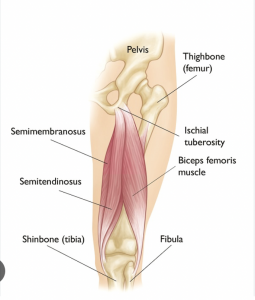Hamstring Injuries
For those of whom follow the Premier League, you may have already heard of Kevin De Bruyne’s debilitating hamstring injury, leaving him out of play for at least 4 months, at a devastating loss for Manchester City’s starting XI. At Goodall Healthcare Group, for our Sports and Exercise Medicine specialists, hamstring injuries form a large part of injuries that we rehabilitate and help prevent.
Let’s explore how GHG can help.
The types of Hamstring Injuries
The main injuries that affect the hamstring. One involves the long head of the biceps femoris tendon, the other affecting the semi-membranosus. The latter usually injured through high kicks or sliding tackles as they involve over-lengthening of the tendon.
The parts of the hamstring muscle are visualised below:
 Picture : OrthoInfo.
Picture : OrthoInfo.
What are some reasons that the Hamstrings are prone to injury?
- Poor warm-up preparations.
- Poor Cardiorespiratory fitness.
- Instability in the lower spine and pelvic area.
- Fatigue due to overuse.
- Lack of flexibility and poor posture.
So how do we rehabilitate a Hamstring Injury?
As with every injury, there are phases in rehabilitation. The goals for hamstring rehab are to protect the healing tissue, to minimise muscle loss and therefore strength loss and to maintain range of motion. Your GHG clinician may use soft tissue mobilisation techniques as part of manual therapy or use Shockwave therapy, especially if the injury is chronic. The combination of manual and shockwave therapy will help to promote blood flow and stimulate cell activity to help overcome the breakdown of collagen at the top of the hamstring which leads to the degeneration of the tendon.
At GHG we also combine all our treatment with exercise therapy. For Hamstring rehabilitation, you can expect a combination of exercises such as Nordic Hamstring Exercises, single leg balance and hip strengthening exercises. Our personal trainers can help with the maintenance of cardiorespiratory fitness, looking at effectively using a stationary bike or the treadmill to progressively increase the tolerance of the hamstring.
With your co-operation in the treatment pathway, which is tailored with your goals in mind you can expect to regain your strength, your full range of motion and remain pain free whilst being able to perform those key sport specific movements – criteria which are essential for a full return to sport.
But it doesn’t end there! Goodall Healthcare Group recommend all those with previous injury to come and have maintenance sessions with our MSK professionals. Previous injury is a key risk factor for future injury and therefore it’s our responsibility to be your one-stop for prevention too. So, even though you might be a Sunday League player instead of on the Belgian National team, it’s important to remember that Hamstring Injuries are common and that all the help you’ll need is at Goodall Healthcare Group.